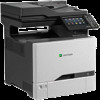Lexmark XC4143 Users Guide PDF - Page 255
Power consumption, Product power consumption, Sleep Mode
 |
View all Lexmark XC4143 manuals
Add to My Manuals
Save this manual to your list of manuals |
Page 255 highlights
Notices 255 or prescribed service conditions. The printer has a non-serviceable printhead assembly that contains a laser with the following specifications: Class: IIIb (3b) AlGaInP Nominal output power (milliwatts): 15 Wavelength (nanometers): 650-670 Power consumption Product power consumption The following table documents the power consumption characteristics of the product. Note: Some modes may not apply to your product. Mode Description Power consumption (Watts) Printing The product is generating hard‑copy output from electronic inputs. 700 (one-sided); 600 (twosided) Copy The product is generating hard‑copy output from hard‑copy original 460 documents. Scan The product is scanning hard‑copy documents. 85 Ready The product is waiting for a print job. 100 Sleep Mode The product is in a high‑level energy‑saving mode. 1.67 (CX725, CX727, XC4150, XC4153); 1.66 (XC4140, XC4143) Hibernate The product is in a low‑level energy‑saving mode. 0.2 Off The product is plugged into an electrical outlet, but the power switch 0.2 is turned off. The power consumption levels listed in the previous table represent time-averaged measurements. Instantaneous power draws may be substantially higher than the average. Values are subject to change. See www.lexmark.com for current values. Sleep Mode This product is designed with an energy-saving mode called Sleep Mode. The Sleep Mode saves energy by lowering power consumption during extended periods of inactivity. The Sleep Mode is automatically engaged after this product is not used for a specified period of time, called the Sleep Mode Timeout. Factory default Sleep Mode Timeout for this product (in minutes): 1 By using the configuration menus, the Sleep Mode Timeout can be modified between 1 minute and 120 minutes. If the print speed is less than or equal to 30 pages per minute, then you can set the timeout only up to 60 minutes. Setting the Sleep Mode Timeout to a low value reduces energy consumption, but may increase the response time of the product. Setting the Sleep Mode Timeout to a high value maintains a fast response, but uses more energy.















